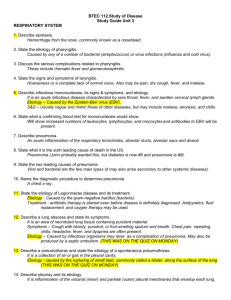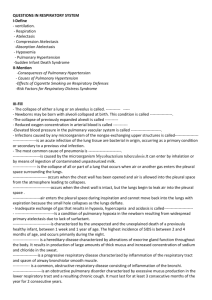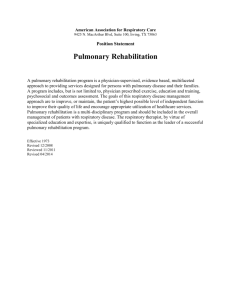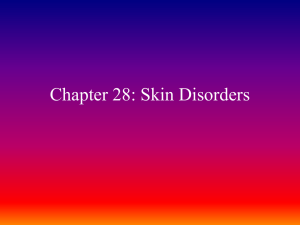Respiratory System Diseases / Disorders and Diagnostic Terms
advertisement
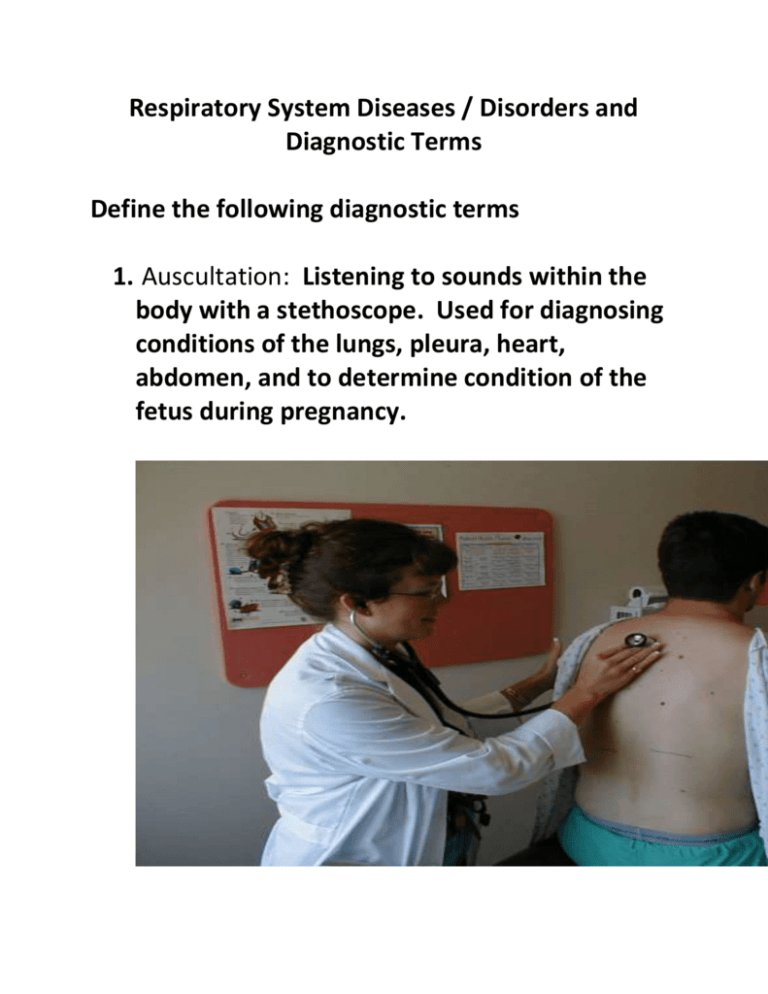
Respiratory System Diseases / Disorders and Diagnostic Terms Define the following diagnostic terms 1. Auscultation: Listening to sounds within the body with a stethoscope. Used for diagnosing conditions of the lungs, pleura, heart, abdomen, and to determine condition of the fetus during pregnancy. 2. Percussion: Tapping on a surface to determine the difference in the density of the underlying structure. Tapping over solid organ produces dull sound without resonance. Percussion over an air-filled structure produces a resonant, hollow note. As lungs fill with fluid and become more dense, as in pneumonia, resonance is replaced by dullness. http://www.youtube.com/watch?v=91qrsYGKdUg 3. Pleural Rub: Grating sound produced by motion of pleural surfaces rubbing against each other; also called a friction rub. Occurs when pleura are thickened by inflammation, scarring or neoplastic cells. Heard by auscultation and can be felt by placing fingers on chest wall. http://www.youtube.com/watch?v=t2QE0O_ex AQ 4. Rales (crackles): Abnormal crackling sounds heard during inspiration when there is fluid, blood, or pus in the alveoli. http://www.youtube.com/watch?v=gOB0nM0 PRTc 5. Sputum: Material expelled from the chest by coughing or clearing the throat. Purulent, containing pus, sputum results from infection and is often green or brown. Blood-tinged sputum makes a physician suspicious of tuberculosis 6. Stridor: A strained, high-pitched, noisy sound made on inspiration; it is associated with obstruction of the larynx, trachea, or a bronchus. http://www.youtube.com/watch?v=Qbn1Zw5CTbA 7. Wheezes: Musical sounds usually heard during expiration http://www.youtube.com/watch?v=YG0-ukhU1xE Define the following diseases and disorders including the etiology and treatment when indicated. Upper Respiratory Disorders 8. Croup: Acute respiratory syndrome in children and infants; characterized by obstruction of the larynx, barking cough, and stridor a. Etiology: infection, allergy, or presence of a foreign body in the larynx 9. Diphtheria: Acute infection of the throat and upper respiratory tract caused by diphtheria bacteria. Inflammation and leathery, opaque membrane forms in pharynx and respiratory tract. a. Etiology: diphtheria bacteria b. Rx. for Prevention: DPT Vaccination 10. Epistaxis: Nosebleed a. Etiology: Traumatic or spontaneous rupture of blood vessels in mucous membrane of nose 11. Pertussis: Bacterial infection of the pharynx, larynx, and trachea caused by Bordetella pertussis, a highly contagious bacterium. AKA whooping cough a. Etiology: Bordetella pertussis Bronchial Tube Disorders 12. Asthma: Spasm and narrowing of bronchi, which leads to bronchial airway obstruction a. Etiology: Allergy, infection; may be aggravated by anxiety, cold, and exercise. b. Rx: Drugs including inhaled agents that dilate the bronchi 13. Bronchogenic Carcinoma: Cancerous tumors arising from a bronchus; lung cancer a. Etiology: Cigarette Smoking b. Rx.: Surgery, chemotherapy, radiation 14. Chronic Bronchitis: Inflammation of the bronchi that persists for a long time. Increased secretion from the bronchial mucosa and obstruction of the respiratory passages. a. Etiology: Infection, cigarette smoking 15. Cystic Fibrosis: Inherited disease of exocrine glands (pancreas, sweat glands, and mucous membranes of the respiratory tract) that leads to airway obstruction. Chronic respiratory infections are common as is pancreatic insufficiency (fats are improperly digested). a. Etiology: Inherited b. Rx.: Replacement of pancreatic enzymes and treatment of pulmonary obstruction and infection. Lung Disorders 16. Atelectasis: Incomplete expansion of alveoli; collapsed, functionless, airless lung or portion of a lung. a. Etiology: Poor inspiration effort in postoperative period, blockage of a bronchus or smaller bronchial tube by secretions, and a tumor or a chest wound that permits air, fluid, or blood to accumulate in the pleural cavity. Rx.: Removal of underlying cause such as tumor, foreign body, excessive mucous secretions, etc., and therapy to open airways – chest tube 17. Emphysema: Hyperinflation of air sacs with destruction of alveolar walls a. Etiology: Cigarette smoking and chronic bronchitis 18. Pneumonia: Acute inflammation and infection of alveoli, which fill with pus or products of the inflammatory reaction. a. Etiology: pneumococci, staphylococci, fungi, viruses b. Rx.: Antibiotics, supplemental oxygen, and respiratory therapy 19. Pulmonary Abscess: Large collection of pus (bacterial infection) in the lungs. Pulmonary abscess of a rabbit lung. 20. Pulmonary Edema: Swelling and fluids in the air sacs and bronchioles a. Etiology: CHF b.Rx.: Immediate Medical RX of drugs such as diuretics, vasodilators, digitalis, and oxygen in high concentrations and keep pt. in sitting position. 21. Pulmonary Embolism: Blood clot or other material lodges in vessels of the lung. 22. Tuberculosis: Infectious disease caused by Mycobacterium tuberculosis; lungs are usually involved, but any organ in the body may be affected a. Etiology: Rod-shaped bacteria, bacilli, invade lungs and produce small tubercles (swelling) of infection b. Rx.: Antituberculous chemotherapy; Treat with many drugs at the same time to prevent drug resistance. Pleural disorders 23. Mesothelioma: A malignant tumor arising in the pleura a. Etiology: exposure to asbestos 24. Pleural Effusion: Escape of fluid into the pleural cavity 25. Pleurisy: Inflammation of the pleura 26. Pneumothorax: Accumulation of air or gas in the pleural cavity. a. Etiology: May occur in the course of a pulmonary disease when rupture of any pulmonary lesions near the pleural surface allows communication between an alveolus or bronchus and the pleural cavity. May follow trauma and perforation of chest wall or prolonged high-flow oxygen delivered by a respirator in an intensive care unit.






